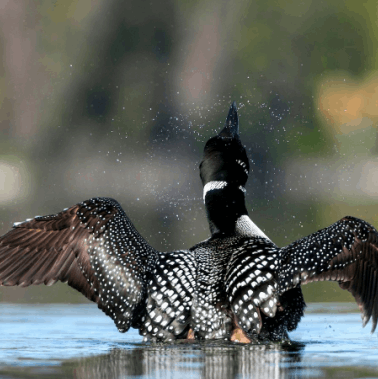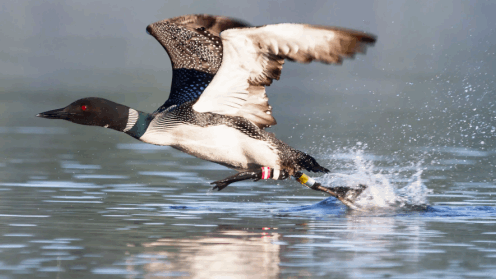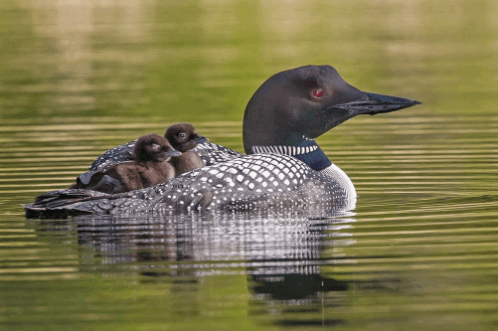英語ネイティブの翻訳者から、ハシグロアビ(Common loon)について話を聞きました。
2020年12月4日 15時11分
※英語原文は日本語記事の下に掲載しています。
ハシグロアビ(Common loon)は、大きくて、赤い目をした白黒の水鳥で、
夏の繁殖期にはカナダ全土で、冬には北アメリカの海岸沿いで見ることができます。
ハシグロアビは泳ぎが非常に上手な鳥です。
足は胴体の後部に付いており、水掻きが付いたつま先と
並外れてしっかりとした骨を持っているため、水中でも機敏に動くことができます。
泳ぎに適している鳥のため、陸での生活は得意とせず、
岸に上がるのは交尾をして巣作りをするときだけです。
飛ぶ時さえも、水の力が必要で、飛び立つのに十分なスピードを得るために、
水面にバタバタと羽を打ち付け、助走を行います。
ハシグロアビは水鳥であるため、主に魚を食べます。
好物は、パーチ、ナマズ、小魚などで、
獲物を追いかけて75メートルの深さまで潜ることができます。
ハシグロアビにはかなりの数の天敵がいますが、
潜水スキルを活かして、彼らを巧みに避けます。
様々な鳥、魚、陸生哺乳動物がアビを捕食することが同様に知られています。
春夏にハシグロアビは湖畔に巣作りを始め、
親鳥は雌雄交代で約1ヶ月に渡って卵を温めます。
卵が孵化すると雛はすぐに巣を離れ、親鳥の背中に乗っている姿がよく見られます。
ハシグロアビの幼鳥は11週間程で飛ぶことができるようになり、
12週間程で、自力で生きられるよう親鳥に突き放されます。
若いハシグロアビは、冬には群れを成して、親鳥たちを追って南へ渡ります。
ハシグロアビは特徴的な鳴き声を出すことでもよく知られており、
狩りをするときに出す、オオカミの遠吠えのような声は最も有名です。
つがいはお互いの場所を把握するためにこの鳴き声を利用します。
多くの人にとって、ハシグロアビの鳴き声は、
カナダの手つかずの大自然の荒々しさを体現するものです。
Link to hear loon calls: https://www.allaboutbirds.org/guide/Common_Loon/sounds
ハシグロアビの鳴き声はこちらから聞くことができます。

夏羽のハシグロアビはお腹が白く、黒い背中には白斑が見られます。

ハシグロアビは、離陸するために水面を走らなければいけません。

ハシグロアビの親鳥はよく雛鳥を背中に乗せて運んでいます。
ハシグロアビ(Common loon)は、大きくて、赤い目をした白黒の水鳥で、
夏の繁殖期にはカナダ全土で、冬には北アメリカの海岸沿いで見ることができます。
ハシグロアビは泳ぎが非常に上手な鳥です。
足は胴体の後部に付いており、水掻きが付いたつま先と
並外れてしっかりとした骨を持っているため、水中でも機敏に動くことができます。
泳ぎに適している鳥のため、陸での生活は得意とせず、
岸に上がるのは交尾をして巣作りをするときだけです。
飛ぶ時さえも、水の力が必要で、飛び立つのに十分なスピードを得るために、
水面にバタバタと羽を打ち付け、助走を行います。
ハシグロアビは水鳥であるため、主に魚を食べます。
好物は、パーチ、ナマズ、小魚などで、
獲物を追いかけて75メートルの深さまで潜ることができます。
ハシグロアビにはかなりの数の天敵がいますが、
潜水スキルを活かして、彼らを巧みに避けます。
様々な鳥、魚、陸生哺乳動物がアビを捕食することが同様に知られています。
春夏にハシグロアビは湖畔に巣作りを始め、
親鳥は雌雄交代で約1ヶ月に渡って卵を温めます。
卵が孵化すると雛はすぐに巣を離れ、親鳥の背中に乗っている姿がよく見られます。
ハシグロアビの幼鳥は11週間程で飛ぶことができるようになり、
12週間程で、自力で生きられるよう親鳥に突き放されます。
若いハシグロアビは、冬には群れを成して、親鳥たちを追って南へ渡ります。
ハシグロアビは特徴的な鳴き声を出すことでもよく知られており、
狩りをするときに出す、オオカミの遠吠えのような声は最も有名です。
つがいはお互いの場所を把握するためにこの鳴き声を利用します。
多くの人にとって、ハシグロアビの鳴き声は、
カナダの手つかずの大自然の荒々しさを体現するものです。
Link to hear loon calls: https://www.allaboutbirds.org/guide/Common_Loon/sounds
ハシグロアビの鳴き声はこちらから聞くことができます。

夏羽のハシグロアビはお腹が白く、黒い背中には白斑が見られます。

ハシグロアビは、離陸するために水面を走らなければいけません。

ハシグロアビの親鳥はよく雛鳥を背中に乗せて運んでいます。
~編集後記~
ハシグロアビの鳴き声をいくつかの動画で聞いてみましたが、美しく、どこか切なさを感じさせるような声でした。カナダの大自然の静けさのなかで聞こえる鳴き声は、また特別なものなのでしょう。
(英語原文)
The Common Loon
The common loon is large, red-eyed, black and white waterbird found throughout Canada in the breeding season of summer, and along the coasts of North America in the winter. They are highly adept swimmers, with legs set far back on their body and webbed toes, as well as unusual solid bones, which allow for their underwater agility. As adapted to swimming as they are, loons are awkward on land and only come to shore to mate and nest. Even to fly they must rely on water, where they will flap their wings and run across the surface in order to gain enough speed for take-off.
As an aquatic bird, the loon mostly feeds on fish, favouring perch, catfish, and minnows. It can dive to depths of 75 meters in pursuit of its prey. Loons also use their diving skills to evade predators, of which they have quite a few. Various birds, fish, and land mammals alike have been known to prey on loons.
Spring and summer are when loons begin nesting on lakesides. Eggs are incubated for about a month by both parents, after which hatchlings leave the nest almost immediately, and are often seen riding on their parents’ backs. Juvenile loons can fly after about 11 weeks, and are left to fend for themselves after about 12. Young loons will flock and migrate together, following their parents south in the winter.
Loons are best known for their distinct vocalizations, the most famous of which is their haunting, wolf-like howl. Mates will use this call to figure out each other’s location. To many, this wail embodies the wilderness and solitude of the Canadian North.
Link to hear loon calls: https://www.allaboutbirds.org/guide/Common_Loon/sounds
(写真上記)
In the summer, the loon sports a white belly and white patterns across its black back.
(写真上記)
Loons must run on the surface of water to become airborne.
(写真上記)
Loon parents often carry around offspring on their backs.
The common loon is large, red-eyed, black and white waterbird found throughout Canada in the breeding season of summer, and along the coasts of North America in the winter. They are highly adept swimmers, with legs set far back on their body and webbed toes, as well as unusual solid bones, which allow for their underwater agility. As adapted to swimming as they are, loons are awkward on land and only come to shore to mate and nest. Even to fly they must rely on water, where they will flap their wings and run across the surface in order to gain enough speed for take-off.
As an aquatic bird, the loon mostly feeds on fish, favouring perch, catfish, and minnows. It can dive to depths of 75 meters in pursuit of its prey. Loons also use their diving skills to evade predators, of which they have quite a few. Various birds, fish, and land mammals alike have been known to prey on loons.
Spring and summer are when loons begin nesting on lakesides. Eggs are incubated for about a month by both parents, after which hatchlings leave the nest almost immediately, and are often seen riding on their parents’ backs. Juvenile loons can fly after about 11 weeks, and are left to fend for themselves after about 12. Young loons will flock and migrate together, following their parents south in the winter.
Loons are best known for their distinct vocalizations, the most famous of which is their haunting, wolf-like howl. Mates will use this call to figure out each other’s location. To many, this wail embodies the wilderness and solitude of the Canadian North.
Link to hear loon calls: https://www.allaboutbirds.org/guide/Common_Loon/sounds
(写真上記)
In the summer, the loon sports a white belly and white patterns across its black back.
(写真上記)
Loons must run on the surface of water to become airborne.
(写真上記)
Loon parents often carry around offspring on their backs.



